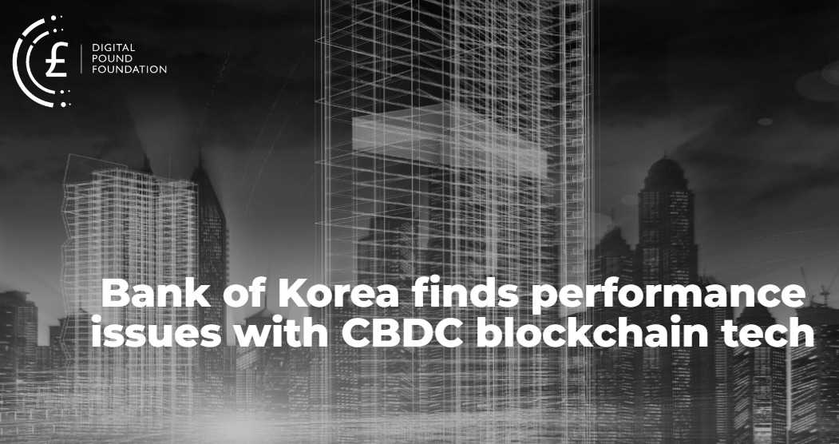- Published: November 7, 2022
The Bank of Korea completed the second phase of its retail central bank digital currency (CBDC) simulations in late June and today shared the results. While it was happy with some aspects of its digital won simulations, such as using CBDC for offline payments and cross border remittances, the central bank highlighted performance issues with the blockchain technology.
Specifically, it found the overall performance of the Ethereum-based blockchain insufficient, including the scaling solutions and privacy technology that was tested.
“There will be some limitations in real-time processing of transactions during peak times”, said the Bank of Korea.
One of its tests simulated peak demand by sustaining 4,200 transactions per second (TPS) for 30 minutes. At that activity level, users sometimes had to wait up to a minute for a response (latency).
However, the system can handle an average TPS of 1,000, which is typical of many Korean micropayment systems, but not peak periods such as lunchtimes or payment deadlines.
The scalability limitations of Ethereum are widely known, and in response, numerous Layer 2 scaling solutions have been deployed in the crypto sector, particularly rollups. The Bank of Korea tried using rollups with up to 700 transactions on each subnetwork. The rollups performed fine when both sides of the transaction took place on the same subnetwork. However, there were very significant performance issues when a large proportion of transactions were between subnetworks.
Another performance challenge related to using zero knowledge proofs (ZKP). This technology can prove that someone owns the CBDC without exposing the details of their identity data. The central bank found using ZKP required up to 14 seconds per transaction. ZKP is also widely known to have performance challenges, although some alternative approaches partly mitigate this. We’re not clear which ones were used.
The bank also tested transfers between ledgers using different blockchain technologies for the purchase of non-fungible tokens and for cross border CBDC remittance. It used hash time lock contracts (HTLC) and was satisfied with these. The cross border CBDC was simulated with the United States and used commercial banks as intermediaries.
CBDC technology partners
As previously reported, the central bank selected Ground X as its primary technology partner for the simulations. Ground X is the web3 subsidiary of Korea’s largest social network Kakao and the founder of the Klaytn public semi-permissioned blockchain. Klaytn is based on Ethereum technology, and for its pitch, it partnered with Ethereum development house ConsenSys, which is still involved in the project.
Other companies involved in the project include Samsung Electronics, KPMG, Kakao Bank, Kakao Pay, S-core (digital transformation consultants), Kona I (prepaid cards), Dream Security (authentication), Zkrypto (zero knowledge proofs), OnTher (layer 2 scaling) and NGLE (software testing).
Now that the second phase of simulations is complete, the central bank has started working with 14 commercial banks and the Korea Financial Telecommunications & Clearings Institute (KFTC). The banks are Kookmin, Shinhan, Woori, Hana, Nonghyup, Enterprise, Suhyup, Busan, Gyeongnam, Daegu, Gwangju, Jeonbuk, Kakao, and K.
Next steps for CBDC
The Bank of Korea outlined its next phase of work which centers around the banks. For example, the ability to integrate the simulation system with the banks’ internal systems. And to check the performance when onboarding large numbers of users. It is creating a Virtual Private Network to communicate securely with these intermediary banks.
Apart from the pure technical aspects, it also plans to explore potential use cases and is considering involving other types of companies in the simulations, such as credit card firms and securities companies.
The central bank also hinted at possible additional cross border experiments. “We plan to cooperate with financial institutions and international organizations,” it said.
Meanwhile, various central banks around the world are progressing with their trials. Both the Monetary Authority of Singapore (MAS) and the European Central Bank (ECB) are separately starting to explore programmable money applications of retail CBDC.
There are an increasing number of cross border CBDC projects. MBridge out of Hong Kong recently shared its latest results and announced plans to go into production. MBridge includes the central banks of Hong Kong, China, UAE and Thailand.
A new Project Mariana, including the central banks of France, Switzerland and Singapore, will explore using DeFi for foreign exchange for cross border CBDC. The New York Fed launched Project Cedar for faster FX settlement. And MAS announced Project Ubin+ for cross border payments. All of these are wholesale CBDC projects.
Two of these, MBridge and Cedar, have created bespoke blockchains in part to address performance challenges.
Additionally, there’s Project Icebreaker involving the central banks of Norway, Sweden and Israel to explore retail CBDC cross border payments.




























